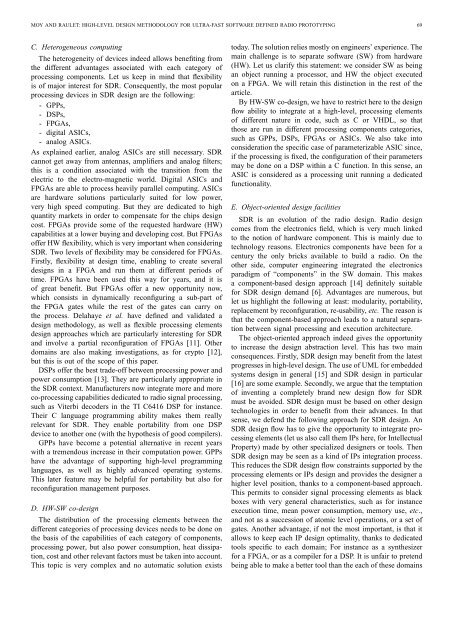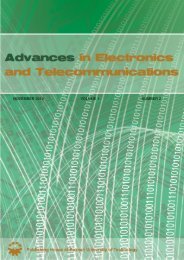channel - Advances in Electronics and Telecommunications
channel - Advances in Electronics and Telecommunications
channel - Advances in Electronics and Telecommunications
You also want an ePaper? Increase the reach of your titles
YUMPU automatically turns print PDFs into web optimized ePapers that Google loves.
MOY AND RAULET: HIGH-LEVEL DESIGN METHODOLOGY FOR ULTRA-FAST SOFTWARE DEFINED RADIO PROTOTYPING 69<br />
C. Heterogeneous comput<strong>in</strong>g<br />
The heterogeneity of devices <strong>in</strong>deed allows benefit<strong>in</strong>g from<br />
the different advantages associated with each category of<br />
process<strong>in</strong>g components. Let us keep <strong>in</strong> m<strong>in</strong>d that flexibility<br />
is of major <strong>in</strong>terest for SDR. Consequently, the most popular<br />
process<strong>in</strong>g devices <strong>in</strong> SDR design are the follow<strong>in</strong>g:<br />
- GPPs,<br />
- DSPs,<br />
- FPGAs,<br />
- digital ASICs,<br />
- analog ASICs.<br />
As expla<strong>in</strong>ed earlier, analog ASICs are still necessary. SDR<br />
cannot get away from antennas, amplifiers <strong>and</strong> analog filters;<br />
this is a condition associated with the transition from the<br />
electric to the electro-magnetic world. Digital ASICs <strong>and</strong><br />
FPGAs are able to process heavily parallel comput<strong>in</strong>g. ASICs<br />
are hardware solutions particularly suited for low power,<br />
very high speed comput<strong>in</strong>g. But they are dedicated to high<br />
quantity markets <strong>in</strong> order to compensate for the chips design<br />
cost. FPGAs provide some of the requested hardware (HW)<br />
capabilities at a lower buy<strong>in</strong>g <strong>and</strong> develop<strong>in</strong>g cost. But FPGAs<br />
offer HW flexibility, which is very important when consider<strong>in</strong>g<br />
SDR. Two levels of flexibility may be considered for FPGAs.<br />
Firstly, flexibility at design time, enabl<strong>in</strong>g to create several<br />
designs <strong>in</strong> a FPGA <strong>and</strong> run them at different periods of<br />
time. FPGAs have been used this way for years, <strong>and</strong> it is<br />
of great benefit. But FPGAs offer a new opportunity now,<br />
which consists <strong>in</strong> dynamically reconfigur<strong>in</strong>g a sub-part of<br />
the FPGA gates while the rest of the gates can carry on<br />
the process. Delahaye et al. have def<strong>in</strong>ed <strong>and</strong> validated a<br />
design methodology, as well as flexible process<strong>in</strong>g elements<br />
design approaches which are particularly <strong>in</strong>terest<strong>in</strong>g for SDR<br />
<strong>and</strong> <strong>in</strong>volve a partial reconfiguration of FPGAs [11]. Other<br />
doma<strong>in</strong>s are also mak<strong>in</strong>g <strong>in</strong>vestigations, as for crypto [12],<br />
but this is out of the scope of this paper.<br />
DSPs offer the best trade-off between process<strong>in</strong>g power <strong>and</strong><br />
power consumption [13]. They are particularly appropriate <strong>in</strong><br />
the SDR context. Manufacturers now <strong>in</strong>tegrate more <strong>and</strong> more<br />
co-process<strong>in</strong>g capabilities dedicated to radio signal process<strong>in</strong>g,<br />
such as Viterbi decoders <strong>in</strong> the TI C6416 DSP for <strong>in</strong>stance.<br />
Their C language programm<strong>in</strong>g ability makes them really<br />
relevant for SDR. They enable portability from one DSP<br />
device to another one (with the hypothesis of good compilers).<br />
GPPs have become a potential alternative <strong>in</strong> recent years<br />
with a tremendous <strong>in</strong>crease <strong>in</strong> their computation power. GPPs<br />
have the advantage of support<strong>in</strong>g high-level programm<strong>in</strong>g<br />
languages, as well as highly advanced operat<strong>in</strong>g systems.<br />
This later feature may be helpful for portability but also for<br />
reconfiguration management purposes.<br />
D. HW-SW co-design<br />
The distribution of the process<strong>in</strong>g elements between the<br />
different categories of process<strong>in</strong>g devices needs to be done on<br />
the basis of the capabilities of each category of components,<br />
process<strong>in</strong>g power, but also power consumption, heat dissipation,<br />
cost <strong>and</strong> other relevant factors must be taken <strong>in</strong>to account.<br />
This topic is very complex <strong>and</strong> no automatic solution exists<br />
today. The solution relies mostly on eng<strong>in</strong>eers’ experience. The<br />
ma<strong>in</strong> challenge is to separate software (SW) from hardware<br />
(HW). Let us clarify this statement: we consider SW as be<strong>in</strong>g<br />
an object runn<strong>in</strong>g a processor, <strong>and</strong> HW the object executed<br />
on a FPGA. We will reta<strong>in</strong> this dist<strong>in</strong>ction <strong>in</strong> the rest of the<br />
article.<br />
By HW-SW co-design, we have to restrict here to the design<br />
flow ability to <strong>in</strong>tegrate at a high-level, process<strong>in</strong>g elements<br />
of different nature <strong>in</strong> code, such as C or VHDL, so that<br />
those are run <strong>in</strong> different process<strong>in</strong>g components categories,<br />
such as GPPs, DSPs, FPGAs or ASICs. We also take <strong>in</strong>to<br />
consideration the specific case of parameterizable ASIC s<strong>in</strong>ce,<br />
if the process<strong>in</strong>g is fixed, the configuration of their parameters<br />
may be done on a DSP with<strong>in</strong> a C function. In this sense, an<br />
ASIC is considered as a process<strong>in</strong>g unit runn<strong>in</strong>g a dedicated<br />
functionality.<br />
E. Object-oriented design facilities<br />
SDR is an evolution of the radio design. Radio design<br />
comes from the electronics field, which is very much l<strong>in</strong>ked<br />
to the notion of hardware component. This is ma<strong>in</strong>ly due to<br />
technology reasons. <strong>Electronics</strong> components have been for a<br />
century the only bricks available to build a radio. On the<br />
other side, computer eng<strong>in</strong>eer<strong>in</strong>g <strong>in</strong>tegrated the electronics<br />
paradigm of “components” <strong>in</strong> the SW doma<strong>in</strong>. This makes<br />
a component-based design approach [14] def<strong>in</strong>itely suitable<br />
for SDR design dem<strong>and</strong> [6]. Advantages are numerous, but<br />
let us highlight the follow<strong>in</strong>g at least: modularity, portability,<br />
replacement by reconfiguration, re-usability, etc. The reason is<br />
that the component-based approach leads to a natural separation<br />
between signal process<strong>in</strong>g <strong>and</strong> execution architecture.<br />
The object-oriented approach <strong>in</strong>deed gives the opportunity<br />
to <strong>in</strong>crease the design abstraction level. This has two ma<strong>in</strong><br />
consequences. Firstly, SDR design may benefit from the latest<br />
progresses <strong>in</strong> high-level design. The use of UML for embedded<br />
systems design <strong>in</strong> general [15] <strong>and</strong> SDR design <strong>in</strong> particular<br />
[16] are some example. Secondly, we argue that the temptation<br />
of <strong>in</strong>vent<strong>in</strong>g a completely br<strong>and</strong> new design flow for SDR<br />
must be avoided. SDR design must be based on other design<br />
technologies <strong>in</strong> order to benefit from their advances. In that<br />
sense, we defend the follow<strong>in</strong>g approach for SDR design. An<br />
SDR design flow has to give the opportunity to <strong>in</strong>tegrate process<strong>in</strong>g<br />
elements (let us also call them IPs here, for Intellectual<br />
Property) made by other specialized designers or tools. Then<br />
SDR design may be seen as a k<strong>in</strong>d of IPs <strong>in</strong>tegration process.<br />
This reduces the SDR design flow constra<strong>in</strong>ts supported by the<br />
process<strong>in</strong>g elements or IPs design <strong>and</strong> provides the designer a<br />
higher level position, thanks to a component-based approach.<br />
This permits to consider signal process<strong>in</strong>g elements as black<br />
boxes with very general characteristics, such as for <strong>in</strong>stance<br />
execution time, mean power consumption, memory use, etc.,<br />
<strong>and</strong> not as a succession of atomic level operations, or a set of<br />
gates. Another advantage, if not the most important, is that it<br />
allows to keep each IP design optimality, thanks to dedicated<br />
tools specific to each doma<strong>in</strong>; For <strong>in</strong>stance as a synthesizer<br />
for a FPGA, or as a compiler for a DSP. It is unfair to pretend<br />
be<strong>in</strong>g able to make a better tool than the each of these doma<strong>in</strong>s







